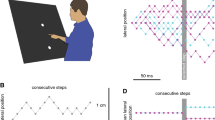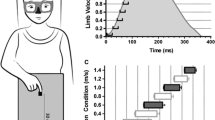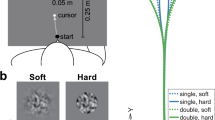Abstract
We provide a solution to a major problem in visually guided reaching. Research has shown that binocular vision plays an important role in the online visual guidance of reaching, but the visual information and strategy used to guide a reach remains unknown. We propose a new theory of visual guidance of reaching including a new information variable, τα (relative disparity τ), and a novel control strategy that allows actors to guide their reach trajectories visually by maintaining a constant proportion between τα and its rate of change. The dynamical model couples the information to the reaching movement to generate trajectories characteristic of human reaching. We tested the theory in two experiments in which participants reached under conditions of darkness to guide a visible point either on a sliding apparatus or on their finger to a point-light target in depth. Slider apparatus controlled for a simple mapping from visual to proprioceptive space. When reaching with their finger, participants were forced, by perturbation of visual information used for feedforward control, to use online control with only binocular disparity-based information for guidance. Statistical analyses of trajectories strongly supported the theory. Simulations of the model were compared statistically to actual reaching trajectories. The results supported the theory, showing that τα provides a source of information for the control of visually guided reaching and that participants use this information in a proportional rate control strategy.










Similar content being viewed by others
References
Bingham GP (1995) The role of perception in timing: feedback control in motor programming and task dynamics. In: Covey E, Hawkins H, McMullen T, Port R (eds) Neural representation of temporal patterns. Plenum Press, New York, pp 129–157
Bingham GP, Pagano CC (1998) The necessity of a perception-action approach to definite distance perception: monocular distance perception to guide reaching. J Exp Psychol Hum Percept Perform 24:145–168
Bingham G, Zaal F (2004) Why tau is probably not used to guide reaches. In: Hecht H, Savelsbergh GJP (eds) Time-to-contact. Elsevier, Amsterdam, pp 371–389
Bingham GP, Zaal F, Robin D, Shull JA (2000) Distortions in definite distance and shape perception as measured by reaching without and with haptic feedback. J Exp Psychol Hum Percept Perform 26(4):1436–1460
Bingham GP, Bradley A, Bailey M, Vinner R (2001) Accommodation, occlusion, and disparity matching are used to guide reaching: a comparison of actual versus virtual environments. J Exp Psychol Hum Percept Perform 27:1314–1334
Bingham GP, Coates R, Mon-Williams M (2007) Natural prehension in trials without haptic feedback but only when calibration is allowed. Neuropsychologia 45:288–294
Bootsma RJ, Peper CLE (1992) Predictive visual information sources for the regulation of action with special emphasis on catching and hitting. In: Proteau L, Elliot D (eds) Vision and motor control. Elsevier, Amsterdam, pp 285–314
Bradshaw MF, Elliott KM (2003) The role of binocular information in the on-line control of prehension. Spat Vis 16:295–309
Bradshaw MF, Elliot KM, Watt SJ, Hibbard PB, Davies IR, Simpson PJ (2004) Binocular cues and the control of prehension. Spat Vis 17:95–110
Coates R, Bingham GP, Mon-Williams M (2008) Calibrating grasp size and reach distance: interactions reveal integral organization of reaching-to-grasp movement. Exp Brain Res 189:211–220
Feldman AG (1986) Once more on the equilibrium-point hypothesis (lambda model) for motor control. J Mot Behav 18:17
Feldman AG, Adamovich SV, Ostry DJ, Flanagan JR (1990) The origin of electromyograms: explanation based on the equilibrium point hypothesis. In: Winters JM, Woo SL (eds) Multiple muscle systems: biomechanics and movement organization. Springer, New York
Flanagan JR, Ostry DJ, Feldman AG (1993) Control of trajectory modifications in target-directed reaching. J Mot Behav 25:140
Georgopoulos AP, Kalaska JF, Massey JT (1981) Spatial trajectories and reaction times of aimed movements: effects of practice, uncertainty, and change in target location. J Neurophysiol 46:725
Gray R, Regan D (1998) Accuracy of estimating time to collision using binocular and monocular information. Vis Res 38:499–512
Hogan N, Bizzi E, Mussa-Ivaldi FA, Flash T (1987) Controlling multi-joint motor behavior. Exerc Sport Sci Rev 15:153
Hopkins B, Churchill A, Vogt S, Rönnqvist L (2004) Braking reaching movements: a test of the constant tau-dot strategy under different viewing conditions. J Mot Behav 36:3–12
Jackson SR, Jones CA, Newport R, Pritchard C (1997) A kinematic analysis of goal-directed prehension movements executed under binocular, monocular, and memory-guided viewing conditions. Vis Cognit 4:113–142
Jeannerod M (1990) The neural and behavioral organization of goal-directed movements. Oxford University Press, Oxford
Lee DN (1976) A theory of visual control of braking based on information about time-to-collision. Perception 5:437–459
Lee YL, Crabtree CE, Norman F, Bingham GP (2008) Poor shape perception is the reason reaches-to-grasp are visually guided online. Percept Psychophys 70:1042–1046
Marzke M (1994) Evolution. Adv Psychol 105:19–35
Melmoth D, Grant S (2006) Advantages of binocular vision for the control of reaching and grasping. Exp Brain Res 171:371–388
Mon-Williams M, Bingham GP (2007) Calibrating reach distance to visual targets. J Exp Psychol Hum Percept Perform 33:645–656
Mon-Williams M, Dijkerman HC (1999) The use of vergence information in the programming of prehension. Exp Brain Res 128:578–582
Regan D, Hamstra SJ (1993) Dissociation of discrimination thresholds for time to contact and for rate of angular expansion. Vis Res 33:447–462
Servos P, Goodale MA (1994) Binocular vision and the on-line control of human prehension. Exp Brain Res 98:119–127
Servos P, Goodale MA, Jakobson LS (1992) The role of binocular vision in prehension: a kinematic analysis. Vis Res 32:1513–1521
Shadmehr R, Wise SP (2005) Computational neurobiology of reaching and pointing: a foundation for motor learning. MIT Press, Cambridge
Sondereren JF, Gon JJD, Gielen CCAM (1988) Conditions determining early modification of motor programmes in response to changes in target location. Exp Brain Res 71:320
Tittle JS, Todd JT, Perotti VJ, Norman JF (1995) Systematic distortion of perceived three-dimensional structure from motion and binocular stereopsis. J Exp Psychol Hum Percept Perform 21:663–678
Todd JT (1981) Visual information about moving objects. J Exp Psychol Hum Percept Perform 7:795–810
Todd JT, Tittle JS, Norman JF (1995) Distortions of three-dimensional space in the perceptual analysis of motion and stereo. Perception 24:75–86
Wann JP, Edgar P, Blair D (1993) Time-to-contact judgment in the locomotion of adults and preschool children. J Exp Psychol Hum Percept Perform 19:1053–1065
Wing AM, Haggard P, Flanagan JR (eds) (1996) Hand and brain: the neurophysiology and psychology of hand movements. Academic Press, San Diego
Yilmaz EH, Warren WH (1995) Visual control of braking: a test of the tau hypothesis. J Exp Psychol Hum Percept Perform 21:996–1014
Zaal F, Bootsma RJ (1995) The topology of limb deceleration in prehension tasks. J Mot Behav 27:193–207
Author information
Authors and Affiliations
Corresponding author
Rights and permissions
About this article
Cite this article
Anderson, J., Bingham, G.P. A solution to the online guidance problem for targeted reaches: proportional rate control using relative disparity τ. Exp Brain Res 205, 291–306 (2010). https://doi.org/10.1007/s00221-010-2361-9
Received:
Accepted:
Published:
Issue Date:
DOI: https://doi.org/10.1007/s00221-010-2361-9




